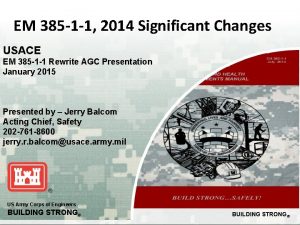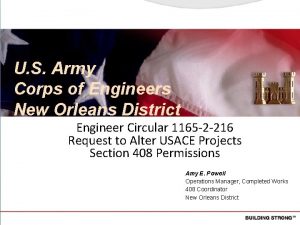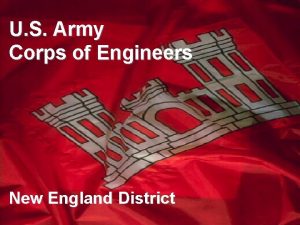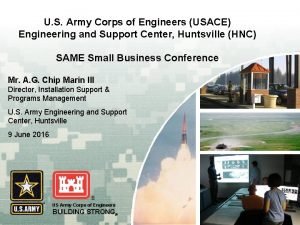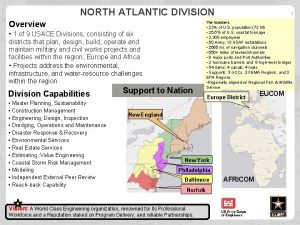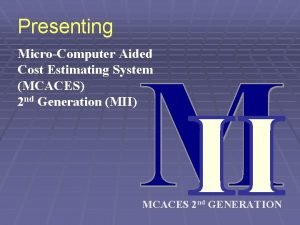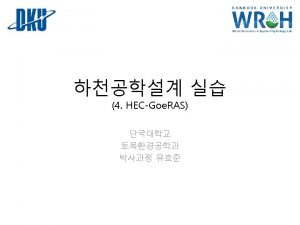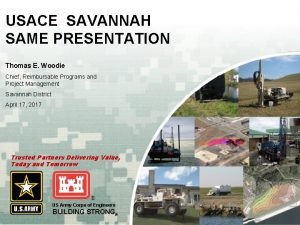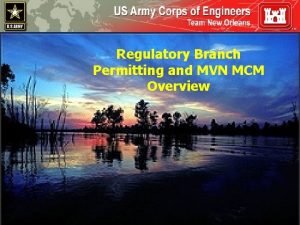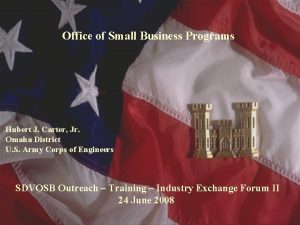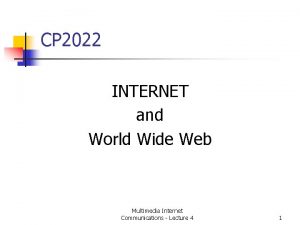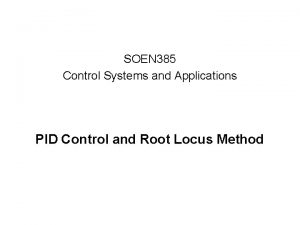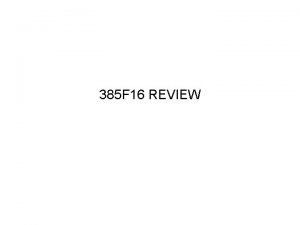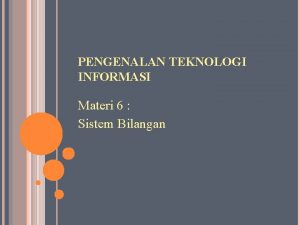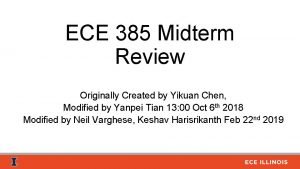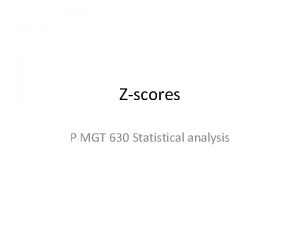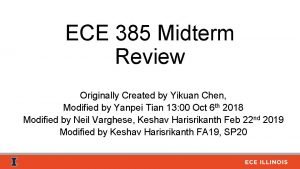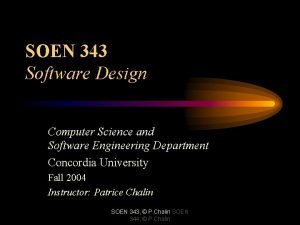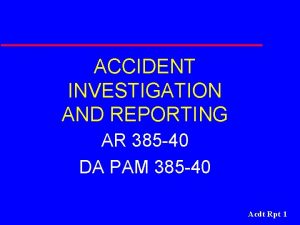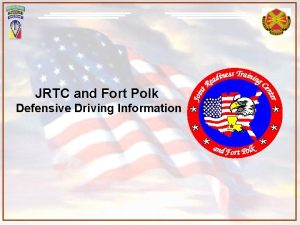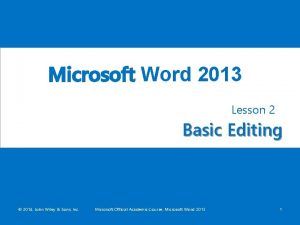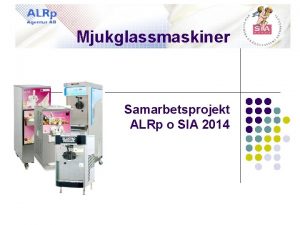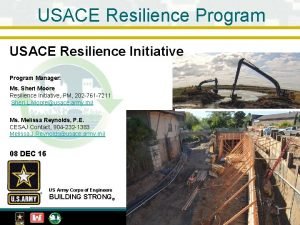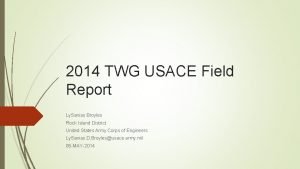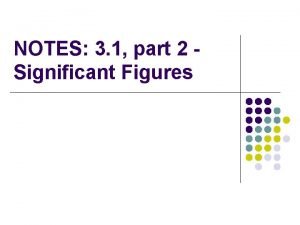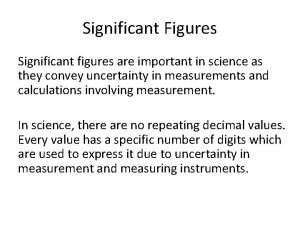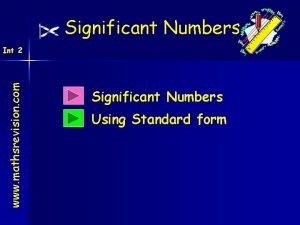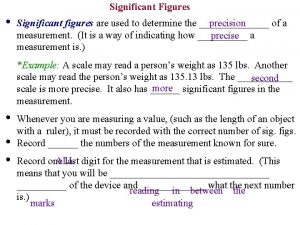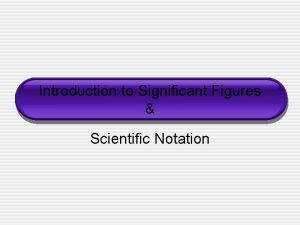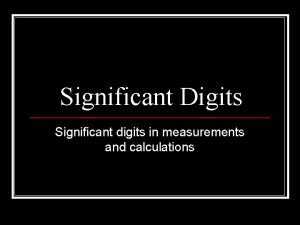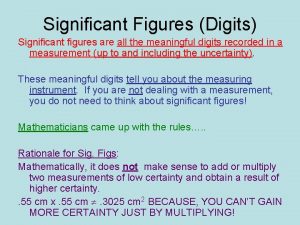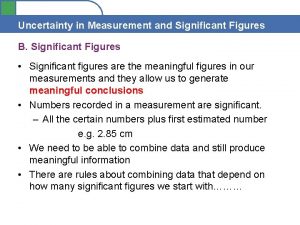EM 385 1 1 2014 Significant Changes USACE



























- Slides: 27

EM 385 -1 -1, 2014 Significant Changes USACE EM 385 -1 -1 Rewrite AGC Presentation January 2015 Presented by – Jerry Balcom Acting Chief, Safety 202 -761 -8600 jerry. r. balcom@usace. army. mil US Army Corps of Engineers BUILDING STRONG®

AGENDA Ø EM 385 -1 -1, 2014 – Format Change Ø Significant changes to EM, [34 Sections / 15 Minutes] Ø How we BOTH need to get the word out to the field. ØQ&As BUILDING STRONG®

Format Change Ø Version Color: Red with the Army Digital background in the middle to recognize our continued efforts to support our Contingency Operations. Ø Table of Contents for each section. Ø Sections are divided by Chapter and Page (e. g. , Section 1 has 30 pages). Layout is 1 -1 through 1 -30. There are 34 sections to the manual. Ø Checklists and Tables are associated now within each section. Ø As changes to the manual are required, CESO will send you out with the page to replace, and why the change was made. BUILDING STRONG®

Situational Awareness Ø The NEW EM was signed on December 14, 2014 by the Chief of Staff. Ø Current Status – Indexing and final check of formatting. Ø Format: 8 -1/2 x 11. Ø Next Steps – Ø Publication - Canvassing of the field for number of manuals to publish. Ø Working with NAVFAC on live side of posting and development of the “app” that will be available to the field Ø Insuring Solicitation Date is coordinated with Contracting Division. BUILDING STRONG®

Section 1 – Program Management 01. A. 02 Employer is responsible for maintaining a SOH Program… Note 1: Supplementation of this manual is not authorized except as published by the SOH Office, HQUSACE. Note 2: Local USACE Commands may develop Standard Operating Procedures (SOPs) to implement the provisions contained within this manual, but may not implement new requirements (e. g. , more stringent, differing in intent, etc. ), without the specific approval of HQUSACE-SO. Rationale: Nationalized Consistency. BUILDING STRONG®

SECTIONS 1 – Program Management 2 – Sanitation 3 – Medical and First Aid Req. 4 – Temporary Facilities 5 – Personal Protective Equip. 6 – Hazardous or Toxic Agents 7 – Lighting 8 – Accident Prevention, Signs, 9 – Fire Prevention and Prot. 10 – Welding and Cutting 11 – Electrical 12 – Control of Haz. Energy 13 – Hand Power Tools 14 – Material Handling 15 – Rigging 16 – Load Handling Operations 17 – Conveyors 18 – Vehicles, Machinery. . 19 – Floating Plants 20 – Pressurized Equip. and Sys. 21 – Fall Protection 22 – Work Platforms and Scaffolding BUILDING STRONG®

SECTIONS 23 – Demolition, Renovation and Re-Occupancy 24 – Safe Access 25 – Excavation and Trenching 26 – Underground Construction 27 – Concrete, Masonry, Roofing and Residential Construction 28 – Steel Erection 29 – Blasting 30 – Diving Operations 31 – Tree Maintenance and Removal 32 – Airfield and Aircraft Operations 33 – Hazardous Waste Operations and Emergency Response (HAZWOPER) 34 – Confined Space Entry BUILDING STRONG®

APPENDICES A – Basic Outline for Accident Prevention Plan B – Emergency Operations C – Process for Interpretations (old Appendix M) D – Process for Waivers and Variances E – Assured Equipment Grounding Conductor Program (old Appendix D) F – Floating Plant / Marine Railing Types (old Appendix U) G – Manning Levels for Dive Teams (old Appendix O) …and Definitions BUILDING STRONG®

Section 1 – Program Management § APP’s with AHA’s submitted in a timely manner that coincides with the Definable Feature of Work (DFOW). § Contractor Risk Management Guidance for DFOW’s. § Contractor SSHO clarification § Fatigue Management Planning § Mishap Reporting and Investigation (High Hazards) BUILDING STRONG®

Section 5 – Personal Protective Equipment § Allows for stickers on hard hats provided they do not interfere with the ability to properly inspect it. § When working at night, on or near sites where vehicle traffic is present, workers (such as, but not limited to, signal persons, spotters, survey crews and inspectors) shall wear, at a minimum a Class 3 highvisibility safety coverall/jumpsuit or a Class 3 highvisibility safety jacket and Class E high-visibility pants, or bib. BUILDING STRONG®

Section 6 – Hazardous / Toxic Environments § Added: “Regular housecleaning (work and break area surface cleaning) and personnel decontamination procedures shall be instituted in areas where the operations generate toxic dust and fume hazards. The frequency of surface cleaning and of decontamination procedures is dependent on the nature of the hazards and frequency and risk from the exposure and shall be documented in the project safety plan or accident prevention plan. ” § Move the Inclement Weather to Section One (1) § Removed the ACGIH tables BUILDING STRONG®

Section 7 - Illumination § Added Section summary statement – not in previous editions. § 07. A Proper illumination of work spaces, project sites, roadways and vessels is imperative to a safe working environment. It is of significant importance in safe vehicular operation and the prevention of slips and falls. § Equipment Requirement added: 07. A. 02 While work is in progress, offices, facilities, access ways, working areas, construction roads, etc. , shall be lighted by at least the minimum light intensities specified in Table 7 -1. Illumination readings shall be taken and recorded whenever proper lighting of an area is in question. A calibrated light meter shall be provided, maintained and used as necessary to provide illumination readings. BUILDING STRONG®

Section 9 – Fire Protection and Prevention § All hot work and hot work permits shall conform to local policy, when present. a. Hot work permits shall be required when performing activities which generate or have the potential to generate, heat, sparks, or open flames, such as abrasive blasting, burning, brazing, cutting, grinding, powder-actuated tools, hot riveting, soldering, thawing activities, welding, or any similar operation capable of initiating fires or explosions. BUILDING STRONG®

Section 11 – Electrical § All hot work and hot work permits shall conform to local policy, when present. a. Hot work permits shall be required when performing activities which generate or have the potential to generate, heat, sparks, or open flames, such as abrasive blasting, burning, brazing, cutting, grinding, powder-actuated tools, hot riveting, soldering, thawing activities, welding, or any similar operation capable of initiating fires or explosions. BUILDING STRONG®

Section 11 – Electrical § ADDED 11. A. 01. e: Emergency Procedures and training. Employees exposed to shock hazard and those employees responsible for taking action in case of emergency shall be trained in methods of release of victims from contact with exposed energized electrical conductors or circuit parts. Employees shall be regularly instructed in methods of first aid and emergency procedures, such as approved methods of resuscitation, if their duties warrant such training. Training of employees in approved methods of resuscitation, including cardiopulmonary resuscitation and automatic external defibrillator (AED) use, shall be certified by the employer annually. > See Section 03. A and OSHA 29 CFR 1910. 151 and NFPA 70 E 110. 2(c). BUILDING STRONG®

Section 15 - Rigging § Rigging equipment shall be inspected as specified by the manufacturer, by a Competent Person (CP), before use on each shift as necessary during its use to ensure that it is safe. The CP must have training and experience equivalent to, or be under the supervision of a Qualified Rigger (QR) as defined in Appendix Q [Definitions]. BUILDING STRONG®

Section 16 – Load Handling Equipment § Changed the “SECTION” title in recognition of how the dynamics of the construction industry is changing. From Excavators to Telehandler, more material is used to…hoist, lower and/or horizontally move suspended loads. § Added the Certificate of Compliance. Similar to what the Navy is currently using. [you received this info in July] § Added the requirement for Standard Lift Plans. KEY PHRASE = Lift or Series of Lifts. § Provided a Non-Mandatory “Critical Lift Plan” format. § Please – Read Section 16. L – Requirements for a Naval Architect Analysis BUILDING STRONG®

Section 21 – Fall Protection § Minimum of 24 -hour Competent Person Training (with hands-on) that meet the ASNI Z 359 standard. Note - USACE has identified at least 5 companies that can meet that requirement. § All full body harnesses shall be equipped with Suspension Trauma preventers such as stirrups, relief steps, or similar in order to provide short-term relief from the effects of orthostatic intolerance. § Effective 2 years from the date of publication, all energy absorbers used shall be equipped with deployment indicator. § Full body harness used around high voltage equipment or structures shall be an industry designed "linemen's FP harness" that will resist arc flashing and shall meet the ASTM F 887 and ANSI Z 359 standards and the equipment must bear a label or similar stating such. BUILDING STRONG®

Section 25 – Excavation and Trenching § 25. A. 01 Excavation/Trenching Plan and Activity Hazard Analysis (AHA). An Excavation/Trenching Plan and/or AHA will be prepared by the Competent Person or a Registered Professional Engineer, submitted and accepted by the GDA prior to beginning operations. § For excavations or trenches greater than 5 ft (1. 5 m) in depth both an AHA and an Excavation/Trenching plan are required. § For excavations/trenches less than 5 ft (1. 5 m) in depth, or made entirely in stable rock, an AHA is required; an Excavation/Trenching plan is optional. § A written rescue plan shall be prepared by the Competent Person or a Registered Professional Engineer, submitted and accepted by the GDA prior to beginning operations and maintained when workers are working at depths of over 5 ft (1. 5 m). § Addressed vertical falls >6 -ft. Discussed leading edges and approach requirements. BUILDING STRONG®

Section 29 - Blasting b. On Military Lands/Installations: § Using commercial explosives, other than for production and Research, Development, Test & Evaluation (RDTE), is prohibited unless commercial explosives are mission essential. § If use of commercial explosives is deemed appropriate, specific authorized by the installation’s ACOM, ASCC or DRU Commander prior to purchasing and bringing the explosives to the installation shall be obtained. > See DA PAM 385 -64, Chapter 21). § Also stated in 01. G Explosives Activities and Operations. BUILDING STRONG®

Section 30 – Diving Operations Added wording in 30. A. 14. c. To deal with diving in contaminated water. Diving in contaminated water is prohibited for all USACE projects unless supporting documentation is provided that demonstrates that divers and topside personnel are not exposed to, or will be protected from, known or potential contamination hazards that would pose a chronic or acute health risk. (1) All divers and topside personnel shall be trained, equipped and resourced to dive in contaminated water. (2) The dive plan shall be accepted by the GDA within 10 business days prior to dive operations and shall specifically address the areas below in accordance with the U. S. Navy Guidance For Diving In Contaminated Waters, SS 521 -AJ-PRO -010 located at the U. S. Navy SEA 00 C 3 website: … BUILDING STRONG®

Section 31, Tree Maintenance) Para 31. A. 02: Tree maintenance or removal shall be performed under the direction of a qualified tree worker and in accordance with references above. The services of a certified arborist may also be necessary to properly access the required maintenance to be performed. Amended to read; The services of other licensed or credentialed professionals may be necessary to properly address the required maintenance to be performed and/or hazards that may be encountered. Examples of credentialed professionals include but are not limited to: TCIAaccredited Tree Care Company, Certified Arborist, Licensed Tree Expert, Certified Treecare Safety Professional (CTSP), Certified Crane Operator/Rigger/Signalperson, or Certified Utility Safety Professional (CUSP). BUILDING STRONG®

Section 32 – Airfield and Aircraft Operations § 32. A. 02 Construction Safety and Phasing Plan (CSPP) and a Safety Plan Compliance Document (SPCD). Prior to the performance of any work upon or around an airfield, a CSPP and a SPCD will be prepared by a Competent Person (CP). The CSPP will follow the guidelines found in the most current edition of Federal Aviation Administration (FAA) Advisory Circular AC No: 150/5370 -2 F, Operational Safety on Airports During Construction. § 32. A. 06 Excavations. Open trenches or excavations are not permitted within the Runway Safety Area while the runway is open or on the Taxiway Surface Area while the taxiway is open. If possible, backfill trenches before the runway or taxiway is opened. If the runway or taxiway must be opened before excavations are backfilled, cover the excavations appropriately. Covering for open trenches must be designed to allow the safe operation of the heaviest aircraft operating on the runway across the trench without damage to the aircraft. BUILDING STRONG®

Section 32 – Airfield and Aircraft Operations § No use of tall equipment (cranes, concrete pumps, etc. ) unless an FAA Form 7460 -1 determination letter is issued for such equipment. § No use of open flame welding or torches unless fire safety precautions are provided and the airport operator has approved their use. § No use of electrical blasting caps on or within 1, 000 ft (300 m) of the airport property. BUILDING STRONG®

Section 33, HAZWOPER (Formally Section 28) 33. B. 01 Added the following two paragraphs § A SSHP is not required for contracts where the site has been fully characterized and there is no known OR anticipated potential for employee contamination-related exposures during the tasks being performed. § If the work meets the criteria in Section 33. B. 01. e and the tasks being performed are limited in scope (e. g. , mowing, routine maintenance, or utility checks of existing equipment as part of long-term maintenance or site management), an abbreviate APP as described in Section 01. A. 12. e may be used in lieu of a full APP. BUILDING STRONG®

Section 34 - Confined Space Entry 34. A. 02 b. On construction sites and/or during O&M activities, all fixed PRCS shall be labeled as a Danger. PRCS that are created as part of construction work shall be labeled and have a barrier to restrict entry. All Non Permit-Required Confined Spaces (NPRCS) created as part of construction and/or O&M activities are not required to be labeled. BUILDING STRONG®

EM 385 -1 -1, 2014 Significant Changes Questions? US Army Corps of Engineers BUILDING STRONG®
 Em 385 1 1 2014
Em 385 1 1 2014 Usace section 408
Usace section 408 Usace new england
Usace new england Aceit usace
Aceit usace Usace north atlantic division
Usace north atlantic division Mcaces
Mcaces Hecras download
Hecras download Usace savannah
Usace savannah Ribits usace
Ribits usace Usace omaha district map
Usace omaha district map Changes in latitudes, changes in attitudes meaning
Changes in latitudes, changes in attitudes meaning Example of chemical and physical change
Example of chemical and physical change 16-385 cmu
16-385 cmu 459-393-385
459-393-385 Soen 385
Soen 385 385 f to c
385 f to c Bentuk bilangan oktal dari bilangan desimal 385
Bentuk bilangan oktal dari bilangan desimal 385 Ece 385 lab 8
Ece 385 lab 8 Mgt 385
Mgt 385 Ece 385
Ece 385 Mgt 385
Mgt 385 Xkcd 385
Xkcd 385 Soen 343
Soen 343 Army accident reporting
Army accident reporting Fort polk dmv
Fort polk dmv Conae 2014
Conae 2014 Microsoft word 2014
Microsoft word 2014 Sia 2014
Sia 2014
